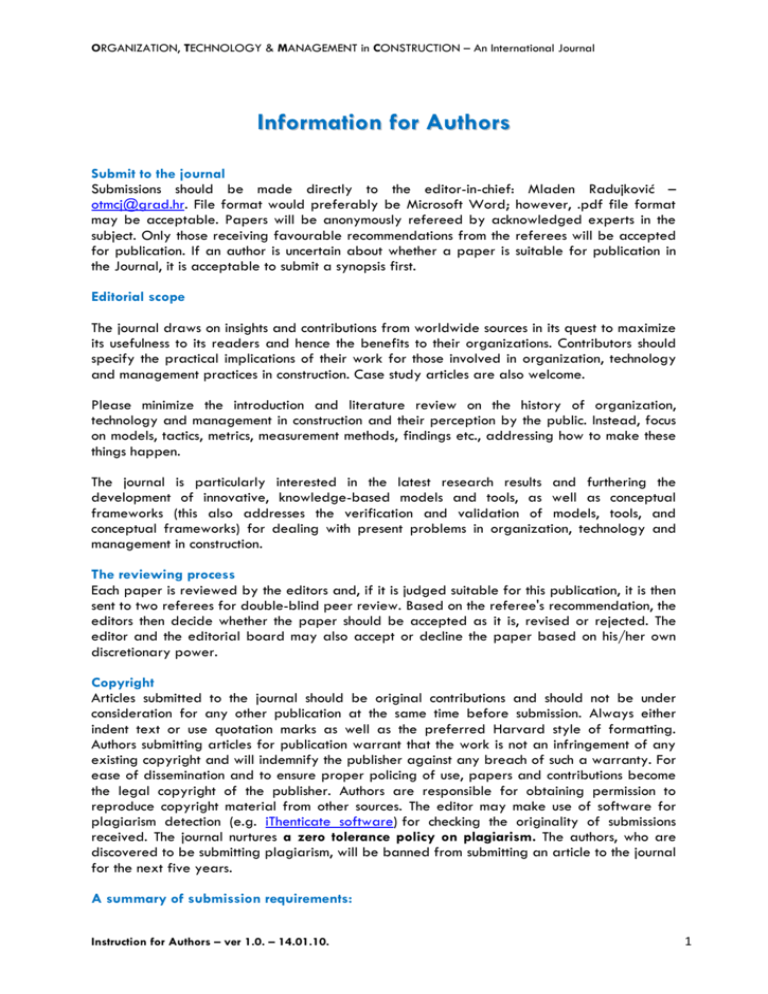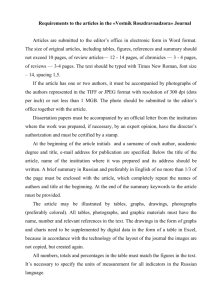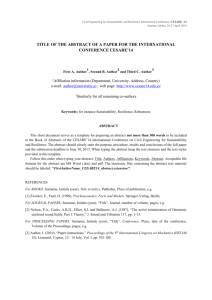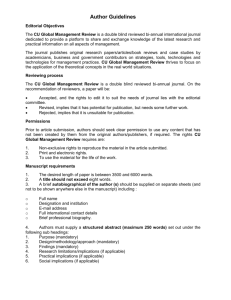Information for Authors
advertisement

ORGANIZATION, TECHNOLOGY & MANAGEMENT in CONSTRUCTION – An International Journal Information for Authors Submit to the journal Submissions should be made directly to the editor-in-chief: Mladen Radujković – otmcj@grad.hr. File format would preferably be Microsoft Word; however, .pdf file format may be acceptable. Papers will be anonymously refereed by acknowledged experts in the subject. Only those receiving favourable recommendations from the referees will be accepted for publication. If an author is uncertain about whether a paper is suitable for publication in the Journal, it is acceptable to submit a synopsis first. Editorial scope The journal draws on insights and contributions from worldwide sources in its quest to maximize its usefulness to its readers and hence the benefits to their organizations. Contributors should specify the practical implications of their work for those involved in organization, technology and management practices in construction. Case study articles are also welcome. Please minimize the introduction and literature review on the history of organization, technology and management in construction and their perception by the public. Instead, focus on models, tactics, metrics, measurement methods, findings etc., addressing how to make these things happen. The journal is particularly interested in the latest research results and furthering the development of innovative, knowledge-based models and tools, as well as conceptual frameworks (this also addresses the verification and validation of models, tools, and conceptual frameworks) for dealing with present problems in organization, technology and management in construction. The reviewing process Each paper is reviewed by the editors and, if it is judged suitable for this publication, it is then sent to two referees for double-blind peer review. Based on the referee's recommendation, the editors then decide whether the paper should be accepted as it is, revised or rejected. The editor and the editorial board may also accept or decline the paper based on his/her own discretionary power. Copyright Articles submitted to the journal should be original contributions and should not be under consideration for any other publication at the same time before submission. Always either indent text or use quotation marks as well as the preferred Harvard style of formatting. Authors submitting articles for publication warrant that the work is not an infringement of any existing copyright and will indemnify the publisher against any breach of such a warranty. For ease of dissemination and to ensure proper policing of use, papers and contributions become the legal copyright of the publisher. Authors are responsible for obtaining permission to reproduce copyright material from other sources. The editor may make use of software for plagiarism detection (e.g. iThenticate software) for checking the originality of submissions received. The journal nurtures a zero tolerance policy on plagiarism. The authors, who are discovered to be submitting plagiarism, will be banned from submitting an article to the journal for the next five years. A summary of submission requirements: Instruction for Authors – ver 1.0. – 14.01.10. 1 ORGANIZATION, TECHNOLOGY & MANAGEMENT in CONSTRUCTION – An International Journal E-mailed paper (please remove authors' information from this file) A brief professional biography of each author Figures, photos, tables, graphics etc. electronically in a separate file Harvard style references where appropriate The copyright statement (can be downloaded from otmcj.grad.hr) Manuscript requirements 1. Articles should be a maximum of 7500 words in length. 2. The manuscript must be in English, typed in single spacing, one column, with a 2.5 cm margin. There should be no separate addenda or notes, or other explanatory material. Possible formats are: MS Word (.doc or .rtf) - disable Allow fast saves or – and .pdf (on the highest possible resolution). 3. It is necessary to follow the format described bellow: Font style: Tw Cen MT Font size: 12 Spacing: single Do not include page numbers 4. Make sure that the first page of your paper includes the title, the abstract and the keywords, but not authorship, affiliation and address details. 5. A title of no more than twelve words should be provided. 6. The biography should include: Full name Affiliation E-mail address Full international contact details Brief professional biography. This information should be provided on a separate sheet (separate file) and authors should not be identified anywhere else in the article. 7. Authors must supply an abstract comprised of the following parts: Brief introduction to the problem (mandatory) Purpose (mandatory) Design/methodology/approach (mandatory) Findings (mandatory) Research limitations/implications (if applicable) Practical implications (if applicable) Social implications (if applicable) Abstract maximum is 250 words in total. Please provide up to seven keywords which emphasize the principal topics of the paper. 8. Categorize your paper under one of these classifications: Research paper (dealing with research of methods, methodologies, models etc.) Technical paper (dealing with application of methods, methodologies, models etc.) Instruction for Authors – ver 1.0. – 14.01.10. 2 ORGANIZATION, TECHNOLOGY & MANAGEMENT in CONSTRUCTION – An International Journal Viewpoint (Should not be longer than 2000 words. Viewpoints may offer comments on other papers published by this Journal - also erratum - or offer original contributions) Case study (Should specify: background and content objectives, i.e. what we were trying to do, eminent events that make this study important, the results and how they were obtained and the implications for others involved in studies of organization, technology and management in construction) Literature review (Literature review should provide a comprehensive overview of the topic reviewed, followed by a critical discussion of the review, giving recommendations for further research) 9. Headings must be short, with a clear indication of the distinction between the hierarchies of headings. The preferred format is for headings to be presented in bold format, with consecutive numbering (e.g. 1., 1.1., 1.1.1. etc.) 10. Notes or Endnotes should be used only if absolutely necessary and must be identified in the text by consecutive numbers, enclosed in square brackets and listed at the end of the article. 11. Each Figure (charts, diagrams and line drawings) and Plate (photographic images) should be supplied in the paper and separately. All Figures and Plates should be of clear quality, in black and white (without shadows or special effects) and numbered consecutively with Arabic numerals. 12. Figures created in MS Word, MS PowerPoint, MS Excel, MS Visio should be saved in their native formats. All figures should be at least 10cm x 10cm. 13. Electronic figures created in other applications should be supplied as separate files in .pdf (select option press quality), .tif, .jpeg (.jpg) , .eps, .psd or .bmp at a resolution of at least 300 dpi. 14. Photographic images (Plates) should be saved as .tif or .jpeg (.jpg) files at a resolution of at least 300 dpi and at least 10cm wide. Digital camera settings should be set at the highest possible resolution/quality. Print screen option is not acceptable! 15. Tables should be typed and included as part of the manuscript. They should not be submitted as graphic elements. Supply succinct and clear captions before all tables, figures and plates. Ensure that any superscripts or asterisks are shown next to the relevant items and have corresponding explanations displayed as footnotes to the table, figure or plate. All tables, figures and plates should be mentioned in the text before they appear. 16. Displayed formulas should be numbered consecutively throughout the manuscript as (1), (2), etc. against the right-hand margin of the page. In cases where the derivation of formulae has been abbreviated, it is of great help to the referees if the full derivation can be presented on a separate sheet (not to be published). Formulas are to be numbered. The number should be written in font size 10 Tw Cent MT in parentheses, aligned to the right margin and next to the formula. 17. Metric units should be used. If other units are used, then metric equivalents should be given in parentheses. Instruction for Authors – ver 1.0. – 14.01.10. 3 ORGANIZATION, TECHNOLOGY & MANAGEMENT in CONSTRUCTION – An International Journal 18. Acknowledgements and information on grants received can be given at the end of the paper, after reference listing. 19. References to other publications must be in Harvard style and carefully checked for completeness, accuracy and consistency. This is very important! You should cite publications in the text: (Adams, 2006) using the first named author's name or (Adams and Brown, 2006) citing either names of two, or (Adams et al., 2006), when there are three or more authors. At the end of the paper a reference list in alphabetical order should be supplied: o For books: Surname, Initials (year), Title of Book, Publisher, Place of publication. e.g. Harrow, R. (2005), No Place to Hide, Simon & Schuster, New York, NY. o For book chapters: Surname, Initials (year), "Chapter title", Editor's Surname, Initials (Ed.), Title of Book, Publisher, Place of publication, pages. e.g. Calabrese, F.A. (2005), "The early pathways: theory to practice – a continuum", in Stankosky, M. (Ed.), Creating the Discipline of Knowledge Management, Elsevier, New York, NY, pp. 15-20. o For journals: Surname, Initials (year), "Title of article", Journal Name, volume, number, pages. e.g. Capizzi, M.T. and Ferguson, R. (2005), "Loyalty trends for the twenty-first century", Journal of Consumer Marketing, Vol. 22 No. 2, pp. 7280. o For published conference proceedings: Surname, Initials (year of publication), "Title of paper", in Surname, Initials (Ed.),Title of published proceeding which may include place and date(s) held, Publisher, Place of publication, Page numbers. E.g. Jakkilinki, R., Georgievski, M. and Sharda, N. (2007), "Connecting destinations with an ontology-based e-tourism planner", in Information and communication technologies in tourism 2007 proceedings of the international conference in Ljubljana, Slovenia, 2007, Springer-Verlag, Vienna, pp. 12-32. o For unpublished conference proceedings: Surname, Initials (year), "Title of paper", paper presented at Name of Conference, date of conference, place of conference, available at: URL if freely available on the internet (accessed date). E.g. Aumueller, D. (2005), "Semantic authoring and retrieval within a wiki", paper presented at the European Semantic Web Conference (ESWC), 29 May-1 June, Heraklion, Crete, available at: http://dbs.unileipzig.de/file/aumueller05wiksar.pdf (accessed 20 February 2007). o For working papers: Surname, Initials (year), "Title of article", working paper [number if available], Institution or organization, Place of organization, date. E.g. Moizer, P. (2003), "How published academic research can inform policy decisions: the case of mandatory rotation of audit appointments", working paper, Leeds University Business School, University of Leeds, Leeds, 28 March. o For encyclopedia entries (with no author or editor): Title of Encyclopedia (year) "Title of entry", volume, edition, Title of Encyclopedia, Publisher, Place of publication, pages. E.g. Encyclopedia Britannica (1926) "Psychology of culture contact", Vol. 1, 13th ed., Encyclopedia Britannica, London and New York, NY, pp. 765-71. (For authored entries please refer to book chapter guidelines above.) o For newspaper articles (authored): Surname, Initials (year), "Article title", Newspaper, date, pages. E.g. Smith, A. (2008), "Money for old rope", Daily News, 21 January, pp. 1, 3-4. o For newspaper articles (non-authored): Newspaper (year), "Article title", date, pages. E.g. Daily News (2008), "Small change", 2 February, p. 7. Instruction for Authors – ver 1.0. – 14.01.10. 4 ORGANIZATION, TECHNOLOGY & MANAGEMENT in CONSTRUCTION – An International Journal o o For electronic sources: if available online the full URL should be supplied at the end of the reference, as well as the date that the resource was accessed. E.g. Castle, B. (2005), "Introduction to web services for remote port lets", available at: http://www-128.ibm.com/developerworks/library/wswsrp/ (accessed 12 November 2007). Standalone URLs, i.e. without an author or date, should be included either within parentheses within the main text, or preferably set as a note (Roman numeral within square brackets within text followed by the full URL address at the end of the paper). Effective communication The paper should be written and arranged in a style that is succinct and easily followed. The reader should be carefully guided through the paper. Always think who your targeted clients/readers are. An informative but short title, a concise abstract with keywords and a wellwritten introduction will help to achieve this. Try to give a few sentences about what you are going to write about, at the end of introduction. Also, try to give a few sentences about the main findings at the beginning of the discussion. Simple language, short sentences and a good use of headings will help to communicate information more effectively. Submissions Process Authors should note that proofs are not supplied prior to publication and ensure that the paper submitted is complete and in its final form. Proofs will be sent to the corresponding author for correction. The difficulty and expense involved in making amendments at proof stage makes it essential for authors to prepare their manuscript carefully: any alterations to the original text are strongly discouraged. Our aim is rapid publication: this will be helped if authors provide good copy, following the above instructions, and return their proofs as quickly as possible. Free article access Corresponding authors will receive free access to their article through our website (otmcj.grad.hr) and a complimentary copy of the issue containing their article. Reprints of articles published in this journal can be purchased only when proofs are received. All questions arising after acceptance of the manuscript, especially those relating to proofs, should be directed to otmcj@grad.hr. Instruction for Authors – ver 1.0. – 14.01.10. 5






